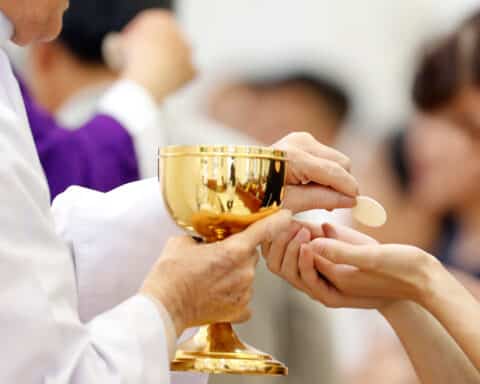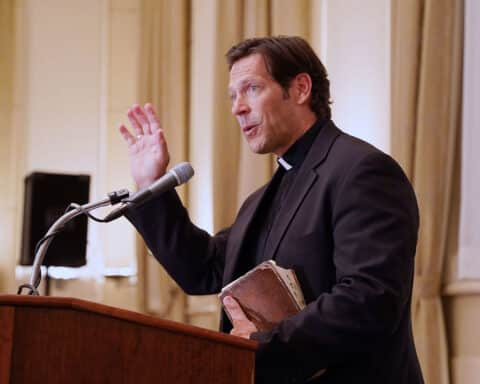As Roman Catholics make their way toward Christmas over the four Sundays of Advent, they might be surprised to learn that their traditions — with its wreaths, candles, colors and hymns — is not celebrated even by all Catholics. For instance, Byzantine Catholics — Eastern-rite Catholics who follow the Byzantine (or Greek) rite, the fourth-century rite used by Eastern Orthodox Churches — prepare for the feast of the Nativity on Dec. 25 with a six-week period of fasting similar to Lent. And while some might call it Byzantine Advent, Father John Custer, rector of the Cathedral of St. Michael the Archangel of the Byzantine Catholic Eparchy of Passaic, New Jersey, says that term doesn’t fit.
“It is not Advent, because it does not share any of the themes of Latin Advent, and it does have a fasting component, which Latin Advent no longer does,” he told Our Sunday Visitor. “In the old-country languages, it’s very clear what you call it. In English, we have a million different names.”
These include the terms St. Philip’s Fast (describing a period of six weeks beginning with the feast of St. Philip on the Byzantine calendar, Nov. 14), the Pre-Christmas Fast or even Nativity Fast. But Father Custer opts for the “old-country name, which is ‘Filipovka’.” (For pronunciation, one can sing it to the tune of “Oklahoma!”)
Fasting in perspective
“The Western Church put more effort into developing the preparation season as a special season unto itself, whereas in the East, what they did with this preparation period was basically mirror Lent,” Father David Meinzen, a priest of the Ukrainian Catholic Eparchy of Chicago based at the University of St. Francis in Fort Wayne, Indiana, told OSV.
Speaking for the Byzantine Ruthenian Church in the USA, Father Custer noted that there are four fasts on the Byzantine calendar, but only the Great Fast (Lent) is mandated by law.
“People undertake the fast voluntarily. Everyone tries to do a little more,” Father Custer said. So for example, “You add Mondays and Wednesdays to your observance of Friday. You fast from meat but not necessarily from dairy.”
Every fasting season has its own unique character and intensity, he added, and part of what makes Filipovka less arduous than the Great Fast is that the liturgical calendar is punctuated with feasts, which relax the fast: Nov. 21 (the entry of Mary into the temple), Nov. 30 (St. Andrew), Dec. 6 (St. Nicholas), Dec. 9 (Mary’s conception). The last two weeks of the liturgical calendar prior to Nativity/Christmas focus on Jesus’ ancestry.
“The prophecies of Isaiah are particularly associated with the Nativity season,” Father Custer noted. “We sing the Emmanuel prophecies at Night Prayer with the refrain: ‘God is with us, understand all you nations: be humbled, for God is with us’ (Is 8:9). Especially in the Old Testament, the ideas of humbling oneself and fasting go together.”

Christmas traditions
For Father Meinzen, tracing the development of Advent between the West and the East reinforces an appreciation of how the Tradition of the Church moved and developed in the first millennium of Christianity’s existence.
“We have to understand. That wasn’t uniformity. There was a great deal of variety,” he said. It’s a variety that his work as a bi-ritual (celebrating worship in both the Latin and Greek rites) priest on a Franciscan campus allows him to experience.
| Needing A ‘Little Lent’ |
|---|
| Both Father Meinzen and Father Custer see the fasting elements of the season as helpful in a U.S. context, where the unabashed consumerism of the pre-Christmas shopping season runs rampant at this time.
“There is no actual celebration of what it means,” Father Meinzen said. Father Custer noted, “People have adopted that culture of early celebration: The stores are already decorated so we decorate our homes early too. We’re not good at delayed gratification. Secular Christmas parties typically happen before Christmas.” He does, however, see the charitable aspects of the secular Christmas season — such as drives to collect food, clothing and toys — as fitting perfectly with Filipovka. “Fasting and charity always go together in our tradition,” he said. “If I simplify my diet, I have money and time to spare for others.” |
“I see a greater richness in both of them because of the other,” he said. “The greatest benefit I’ve received is … to share the full range of patristic reflection on the Incarnation, East and West, and be able to highlight the unity that is there that oftentimes gets missed.”
He noted that the six weeks of fasting before Christmas can even be found in the West, where Franciscans still observe a St. Martin’s Fast, which begins on Nov. 11. In another crossover of traditions, he and his family keep an Advent wreath in their home, but with six candles.
Advent is more developed in the West in part because the East didn’t adopt the Feast of the Nativity until the late fifth century. For Greek Catholics, the older and more important feast is Theophany on Jan. 6, celebrating the baptism of Jesus and the manifestation of the Holy Trinity.
“That’s the celebration that we’ve been preparing for, that God has become one of us,” said Father Meinzen.
Father Custer noted the relative importance of Christmas: “It’s one of the few feasts on the calendar that we actually took from the Latin Church, and as was pointed out to me by a Benedictine monk, we’re still not very good at it. He said, ‘You guys know how to do Easter, but unless you’ve been to Bavaria for Christmas, you’ve never seen Christmas.’ I had to concede the point.”





